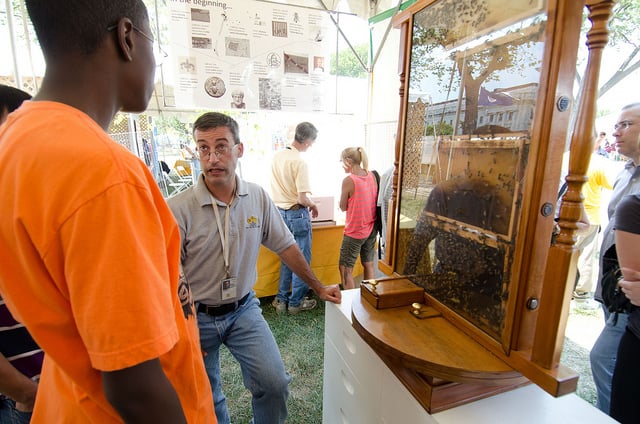The Smithsonian Folklife Festival is an annual festival held on the National Mall in Washington, D.C. that celebrates cultural diversity and traditions. The USDA Bee Research Lab was asked to participate this year as part of the theme “Campus and Community”. The festival commemorated the 150th anniversary of USDA and land-grant universities. Abraham Lincoln signed the Morill Act in 1862 which, in part, initiated research partnerships between USDA and public universities (not unlike the Bee Informed Partnership!)
A group of us from BIP were lucky enough to be able to participate in the festival on June 29th: myself, Karen Rennich, Heather Eversole and Jennie Stitzinger. Along with volunteers from local beekeeper associations, we helped to inform the public about honey bee biology, history and the importance of honeybees in agriculture. Despite the high humidity and scorching 104°F temperature there was a good turnout of people interested in beekeeping.

The observation hive was the main focus of our display. It sat on a very unique stand constructed out of hive boxes made by the folks at BRL. While answering questions about the hive, we also had fun challenging people to try to find the queen or drones.

As the day drew on it became apparent that the heat was just too much for the bees. Every 15 minutes we sprayed water through the vents with a squirt bottle and were pumping air into the hive with a small pump tucked under a table to help circulate the air inside. We were hoping that the bees would evaporate the droplets to bring down the internal temperature of the observation hive. While the bees scurried to the water droplets eagerly each time, I believe there was only so much the water could do. The workers began acting strange, pulling brood out of cells and eating them while the queen scurried around without her attendants. She even began to lay eggs on the glass. At that point we decided to move the observation hive to an air conditioned trailer rather than risk the death of the colony.
The observation hive entrance had to be closed to avoid any of the public getting stung. Because of this, the bees were unable to regulate their temperate by circulating as they do in their hive boxes. Another factor that couldn’t have helped was the two planes of glass acting like a mini-greenhouse despite being in the shade. Even so, I am happy to say that the bees did recover after a blast of AC and were returned to their home at BRL that night.
For more information about the Smithsonian Folklife Festival visit: http://www.festival.si.edu/